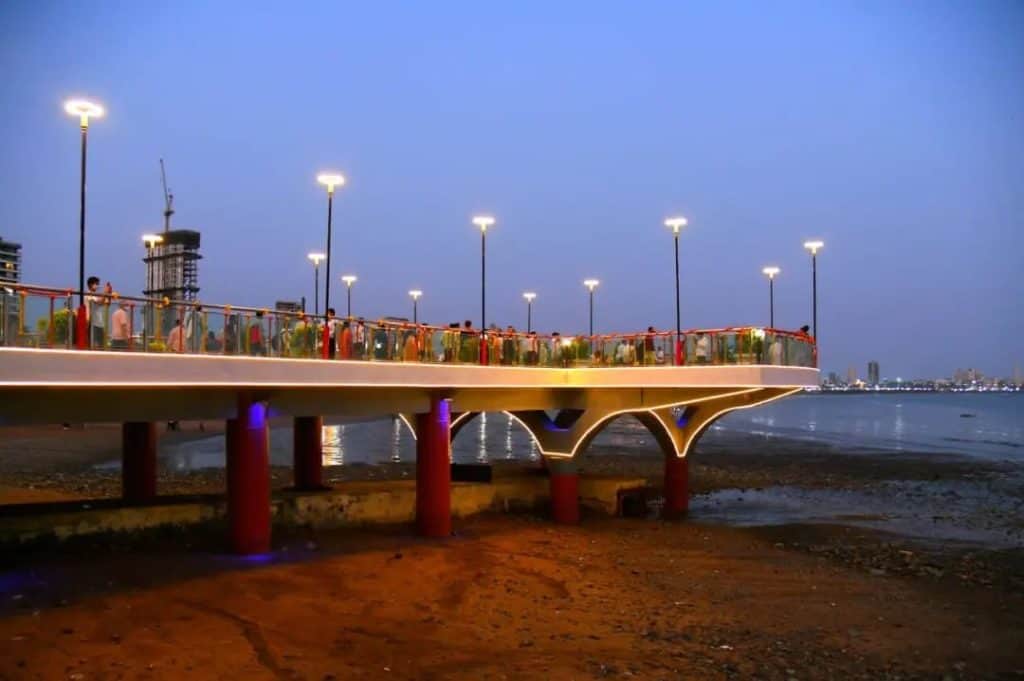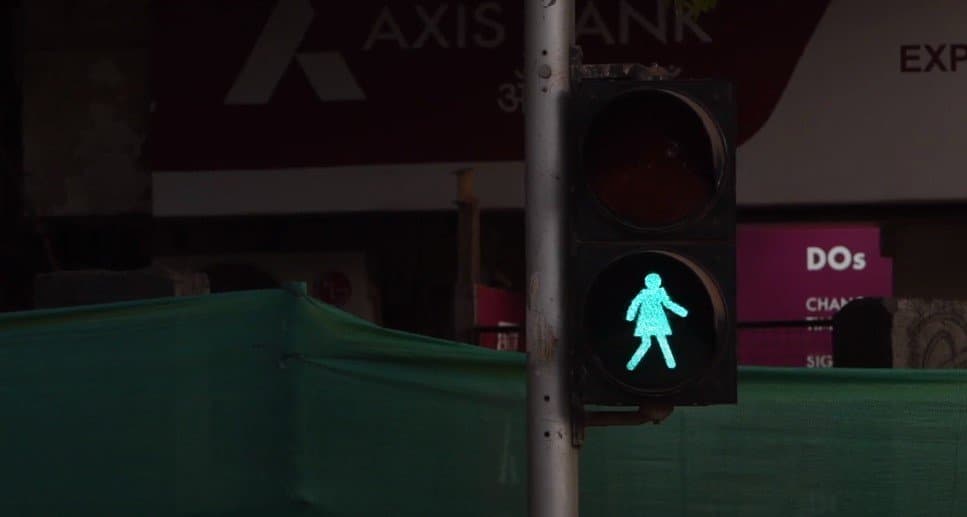A viewing deck over a stormwater outfall in Dadar that looks out onto the sea. Solar-powered electric poles shaped like a tree. Multi-coloured and fun-shaped zebra crossings near school gates. These ideas may seem unrelated, but they share a common thread; they all come under the Brihanmumbai Municipal Corporation (BMC)’s new push towards ‘tactical urbanism’.
Starting January, the drive has sparked off several projects to enhance livability in the city, often on a pilot basis and in local pockets. Some of the steps taken under it are fairly simple and ordinary, such as planting trees along roads, refurbishing bus stops, upgrading community toilets and rejuvenating waterfronts.
Others are more exciting and elaborate, such as setting up sensory parks, revamping railway station areas, turning the space under flyovers into public spaces and public bike-sharing.
“It’s a breath of fresh air,” says Chaarvi Mathur, urban designer and co-founder of Studio Archarrette. “Cities are typically designed by town planning, but tactical urbanism adds an aesthetic touch. Every detail is looked into.”
But what does the term, which appears to contain far-reaching and varied ideas, mean?
“These are relatively small interventions which generate significant impact,” according to the BMC. Short-term, low-cost and scalable, the tactics can be replicated and multiplied if proven to be effective. And an allocation of Rs 50 crore in the 2022-23 budget has been made just for these.

Tactics to increase open spaces
As part of the initiative, the BMC invited professionals in urban planning and development to bring their own ideas to the table. These are showcased in a new video every Thursday, dubbed ‘Tactical Thursdays’.
Featured in one of the videos, Chaarvi introduced the idea of privately-owned public spaces (POPS). “Boundary walls are not a common sight in the West, at least in commercial spaces. You can see huge commercial plazas in Manhattan, where people move from one plot to the other seamlessly,” she says. The commercial district Bandra-Kurla Complex (BKC) is ripe for replicating this.
Bringing down the walls between the “exclusive spaces” would open up a number of possibilities for passers by, explains Chaarvi. A few benches, a tea stall and some trees could convert the alley into a midday hang-out spot. Side-facing shops would see a new set of eyes fall on them. Instead of lengthy detours, pedestrians will be able to cut through to the other side and shorten their commute. Merging the spaces at the margins will result in more ‘eyes on the street,’ making commute safer for women.

As a natural extension, streets too can double up as open spaces in the space-constrained city. They might appear only as connectors between various public and private spaces, but projects at Vikhroli and Senapati Bapat Marg tell a different story.
Temporary measures like road markings, traffic cones, etc, allowed the designers to test a different vision for the roads. Adding trees, seating, modular bus stops, open gym equipment, street art and more turned the extended footpaths and area under the flyover into a fun space. “There is an exponential increase in the children that come to play in the parks, study in the ‘vachnalay’ (library), have jam sessions and dancing sessions. It’s become a place for people to come and gather,” said Mansi Sahu, co-founder of StudioPOD which led the transformation of the stretch at Dadar.
Read more: Mumbai has less green than what masterplan shows: just 1 sq m per person

A different lens to the city
Transformations of these kinds rarely result in quantitative, large-scale impact. Rather, it focuses on the quality a space exudes, which may change how people view and experience it.
Chaarvi hints at the kind of change simple benches on the streetside, or a pop of greenery can bring to the urbanscape. Vijayshree Pednekar, architect at The Urban Project, suggests a swing park for adults as a vehicle to bring joy and leisure for one and all.
Giulia Ambrogi, co-founder of St+art India Foundation, relates how integrating art and beauty on the streets made in collaboration with the locality can spark a sense of belonging. “When everything is grey, when everything is dull, when everything seems to belong to no one, it’s very hard to create an awareness towards what a public space means,” she says.
What a public space is, however, can mean different things for people of different genders, age, class, religion and caste. The mere presence of space does not ensure access. “Men are conditioned to use any space available freely, without fearing stares or judgement,” says Vijayshree. “Design should be sensitive towards difference.”
Some examples of such design can already be seen in the city, in nani-nana (grandparent) parks, tactile paving for the blind, and segregated travel compartments for women and the handicapped. In the same vein, Vijayshree envisioned the swing parks would have a ‘Sakhi Udyaan’, a section just for women that could bloom into a counselling centre.

Children are another population segment that the city needs to extend consideration towards. A pilot programme to implement a safe school zone outside Christ Church school, Byculla, was launched in October 2021, using footpath extensions, vibrant road markings, speed calming measures, among other tactics. Before and after surveys indicated success: 41% of motorists stopped at the crossing, compared to only 10% before. 93% of the children too felt the street was more accessible.

The different approaches in tactical urbanism
The ambit of tactical urbanism is not limited to projects, however. It expands to cover a range of approaches to urban planning and development. Public-private partnerships (PPP) can streamline various entities working in the same field and bring in the funds needed, according to Dr Neville Mehta, CEO of the think-tank Mumbai First.
Shishir Joshi, co-founder of Project Mumbai, talked about making Mumbai the ‘Kindness Capital’ by inculcating a spirit of volunteerism among people. Beach clean-ups and environmental activists show that this is present in small measure, but localised networks classified by areas of interest could turn the spirit into a thriving ecosystem.
Yet the success of these approaches and ideas depends on a simple but crucial factor: community engagement.
“Small interventions involving the locals will create more meaningful outcomes. It will ensure better impact and project success,” says Trupti Amritwar Vaitla, founder of the Mumbai Environment and Social Network (MESN).
The NGO enlisted an advanced locality management (ALM) group in designing and maintaining a park in Govandi; a design exhibition on the skywalk over the Kalanagar traffic junction to improve the junction; and even Minecraft games in design workshops. Sports, art, tree plantations and cleanliness drives can be platforms to reach all stakeholders, and build trust among them.

Nowhere is the involvement of local communities as important as in climate resilience and nature conservation. Coastal and fisher communities face the worst effects of sea-level rise and environmental degradation. At the same time, they are instrumental in mitigating and reducing harm.
“We should not only take their knowledge and suggestions, but ensure they are active participants,” says Sachin Marti, a social worker at the Aga Khan Agency for Habitat. “This way, the local community can take ownership of the waterbody and achieve sustainability.”

Incremental changes
“Tactical urbanism is intelligence which hasn’t been applied to city design till now,” says Om Merchant, the principal founder of Architects Associate, which has partnered with the BMC for several projects under the banner. “It utilises various things, simple modifications, visual connections and reorientation of various elements by giving them intelligent thought. Earlier it was all about constructing and getting it done with.”
“It’s absolutely going to make a big difference in the city,” he says. “It will iron out the problems that have been caused because of unthought-out design.”

However, critics point out that the BMC needs to focus on far more pressing issues and use their funds judiciously instead of splurging on such initiatives.
“A scheme with the fancy name of tactical urbanism is supposed to impress us and Rs 50 crore marked for it to improve the surroundings of schools,” writes Vidyadhar Date, city veteran, former Times of India special correspondent and author of Traffic in the Era of Climate Change. “There are ways of improving the same without the need for any expenditure. But then how will contractors and others make money?”
Urban planners acknowledge the bigger issues that need urgent attention. However, those who favour this initiative point to the freshness and cheer it infuses in otherwise stressful lives, even if momentarily.
“One may say that most of it is only on the surface, and there are a lot of bigger issues that need to be tackled. But it is still serving a lot of people in their day-to-day lives,” says Chaarvi.
The BMC’s projects under tactical urbanism are based on 6 core principles:
1) increasing green cover,
2) reclaiming unused open spaces,
3) promoting the concept of pedestrian first,
4) tapping tourism potential,
5) upgrading access to sanitation, and
6) creating safe and inclusive public spaces.
Citizens are welcome to drop in their own suggestions, demands and ideas for a project through the ‘Submit an idea’ form. Based on the response, feasibility and utility, the ideas under Tactical Thursdays will be taken up for implementation.